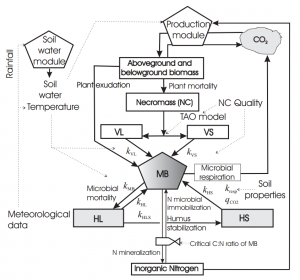Pansu, M., Machado, D., Bottner, P., and Sarmiento, L.: Modelling microbial exchanges between forms of soil nitrogen in contrasting ecosystems, Biogeosciences, 11, 915-927, doi:10.5194/bg-11-915-2014, 2014.
The questions
It is well known that N and C combine to form organic molecules due to biological processes, although they come together from different pathways. C is extracted from carbon dioxide in the atmosphere and used to form reduced molecules thanks to photosynthesis, while mineral forms of nitrogen are extracted from soil by plant roots, just to be processed in a chain of links controlled by microbial activity. Although N and C cycles are strongly linked, published models of the N cycle are not always linked to the C cycle and are sometimes not fully mechanistic. After reviewing recent research, the authors of the paper raise some questions:
- Can the rates of direct enzymatic C and N assimilation be considered to be the same (as in the direct microbial assimilation of all available organic N scheme)?
- Can the transfers of C by microbial mortality and respiration cause simultaneous transfers of N into labile humus and inorganic forms to balance the microbial C:N ratio?
- Can the assimilation of inorganic N be modelled to sustain microbial activity in the case of an N deficit during conversion of organic forms?
- Can microorganisms be assumed to assimilate N from labile and stable organic molecules as well as N from the inorganic N pool?

Flow diagram for the MOMOS model coupled with a soil water module and a production module. MB is the microbial biomass, VL is the labile necromass (NC), VS is the stable necromass, HL is the labile humus and HS is the stable humus. Click to download the paper.
The answers
The paper concludes that the hypothesis of microbial homeostasis can provide robust predictions at global scale, although microbial populations are not always independent of the external constraints. When an altitudinal transect is studied, microbial C:N ratios could be better modelled as decreasing during incubation and increasing with increasing C storage in cold conditions, where CO2-C respiration is reduced by low temperatures. The ratio of potentially mineralizable-15N/inorganic-15N and the 15N stock in plant debris and microorganisms was modelled as increasing with altitude, whereas the 15N storage in stable humus was modelled as decreasing with altitude. This predicts that there is a risk that mineralization of organic reserves in cold areas may increase global warming.
Biogeosciences
Biogeosciences (BG) is an international scientific journal dedicated to the publication and discussion of research articles, short communications and review papers on all aspects of the interactions between the biological, chemical and physical processes in terrestrial or extraterrestrial life with the geosphere, hydrosphere and atmosphere. The objective of the journal is to cut across the boundaries of established sciences and achieve an interdisciplinary view of these interactions. Experimental, conceptual and modelling approaches are welcome. More at Biogeosciences homepage.

